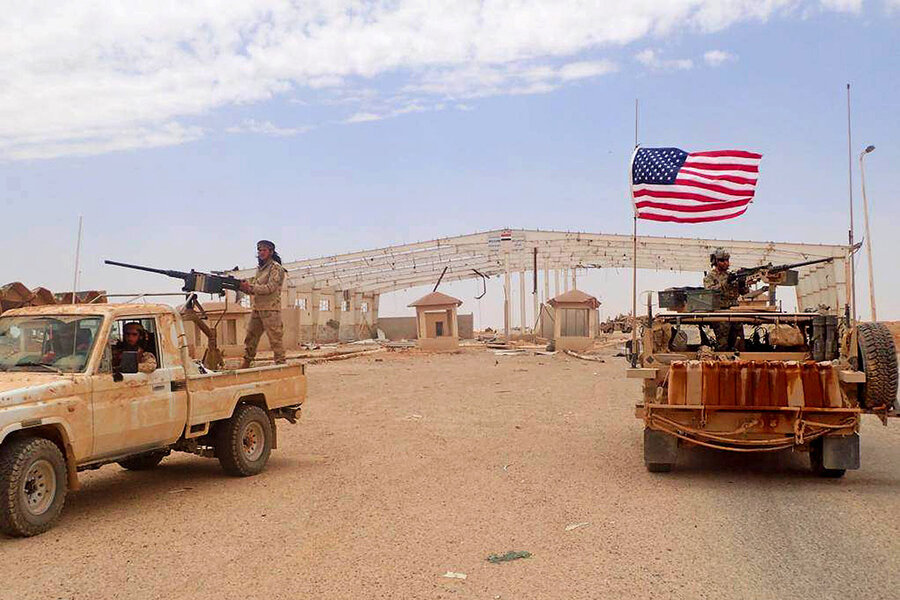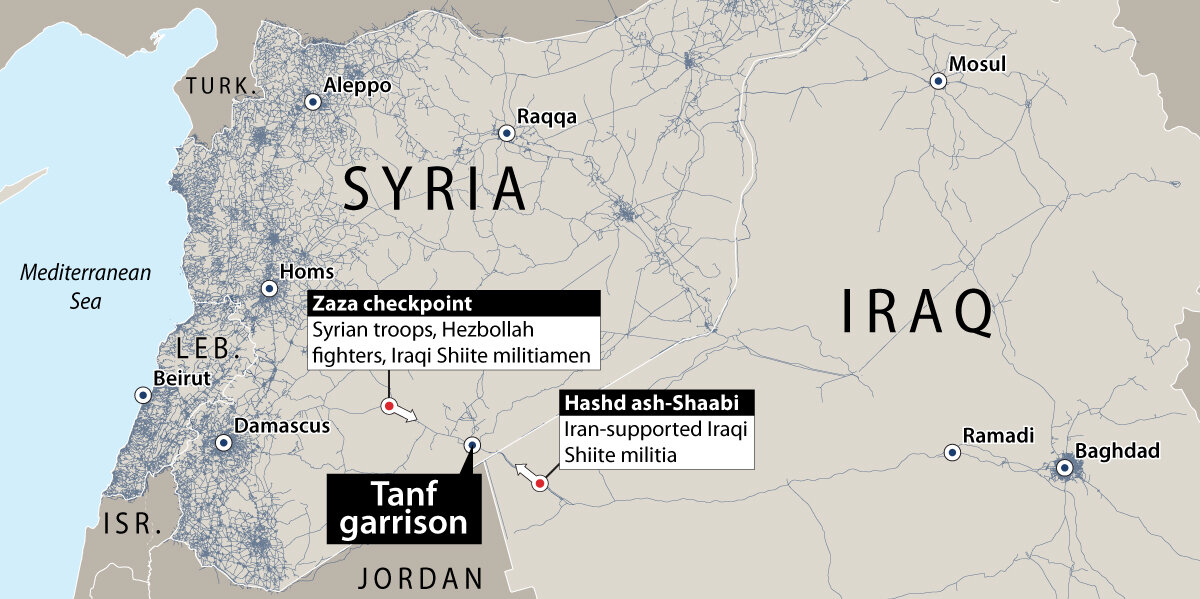At remote desert garrison in Syria, a US-Iran confrontation is brewing
Loading...
| Beirut, Lebanon
US-backed forces announced Tuesday that they had begun the long-awaited assault on the northeastern Syrian city of Raqqa, the so-called Islamic State's main stronghold in the country and its self-declared capital.
But some 170 miles to the south, in a remote corner of Syria’s southeastern desert, another clash is brewing that is pitting the strategic objectives of the United States against those of Iran, and that could soon bring US troops and Iranian-backed forces into direct military confrontation.
Both US and Russian warplanes have been deployed, and some shots have already been fired, including by US-backed coalition forces on Tuesday, the US military said.
The clash is over a military garrison at Tanf, located near a border crossing on a highway that cuts through hundreds of miles of flat desert. It was captured from jihadist forces more than a year ago and is being used by US Special Forces and allies to train Syrian militias to fight ISIS, which controls territory to the northeast.
But if Tanf’s main value to the US so far has been in the war on ISIS, it has also, perhaps unwittingly, become a front-line outpost in the US containment of regional power Iran, whose allies are advancing on the garrison from two directions.
Their interest in the highway is that it links Baghdad and Damascus and serves as a coveted overland route that could provide Iran with access to its strategic Lebanese Shiite ally, Hezbollah.
At a junction on the highway, 50 miles northwest of the garrison in the direction of Damascus, a combined force of Syrian troops, Hezbollah fighters, and Iraqi Shiite militiamen are mobilizing for a southward thrust to seize the Tanf border crossing.
On the Iraqi side of the border, southeast of Tanf, the Hashd ash-Shaabi, an Iran-supported Iraqi Shiite militia sanctioned by Baghdad, is reportedly deploying in readiness to drive ISIS out of Iraqi territory between Tanf and Al-Qaim, another border town 136 miles to the northeast.
And wedged between these two Iranian-backed forces are the US, British, Norwegian, and possibly Jordanian special forces, as well as the Syrian militia groups they have helped to train.
Shots fired
With both sides girding for a fight, the coming days or weeks could see US and allied troops coming into conflict with Iranian-backed forces for the first time in Syria’s six-year civil war.
“I think any assault on Tanf [by Iranian-backed groups] would meet with a vigorous and effective military response,” says Frederic C. Hof, director of the Rafik Hariri Center for the Middle East at the Atlantic Council in Washington and previously a State Department liaison with Syrian opposition forces. “I do not know the rules of engagement in effect for US ground forces, but an Iranian-Hezbollah assault on Tanf would, I think, be quite reckless and not likely to succeed.”
The two sides have already come to blows twice. On May 18, US aircraft attacked a convoy of Shiite militiamen speeding southeast along the highway in breach of a deconfliction zone of some 20 miles around Tanf. Several vehicles were destroyed in the air strike and six militants were killed.
And Tuesday, according to an official statement from the US-led coalition, a pro-regime force again entered the deconfliction zone and was fired upon. Two artillery pieces and an antiaircraft weapon were destroyed, the statement said, and a tank damaged. There was no word on casualties among the 60 fighters reported in the pro-regime force.
Clash is coming
In light of the militia build-up north of Tanf, a spokesman for the Baghdad-based anti-ISIS coalition said last week that “we have increased our presence and footprint” in southern Syria, adding that the mobilization of Iranian-backed militia forces near Tanf was viewed as a “threat.” US aircraft have also dropped leaflets on the militia forces, warning them to stay away from Tanf.
But the Iranian-backed forces and the Syrian army appear determined to seize the Tanf border crossing, even if it risks a confrontation with US forces.
“Our people are gathering in the Tanf area right now, so a clash is definitely coming,” says a Hezbollah unit commander speaking on condition of anonymity in Beirut.
Iran has a strategic interest in gaining control over the crossing as it represents the last remaining link in securing an east-to-west land corridor reaching from Iran to Lebanon on the Mediterranean coast via Iraq and Syria. Guarded by Iranian-backed militias in Iraq and Syria, the transport link would allow Tehran to ferry fighters to Syrian battlefronts and armaments to its Hezbollah ally in Lebanon.
But the US-led coalition against ISIS appears equally determined to defend its presence in this remote spot to maintain its ability to continue its unconventional warfare campaign against ISIS-held territory to the northeast.
At least three Syrian armed groups are operating alongside the Americans and British at Tanf as part of the “train and equip” program to defeat ISIS: the Jaysh Maghawir al-Thawra (Revolutionary Commandos Army), the Ahmad Abdo Martyrs Group, and Jaysh Osoud al-Sharqiya (Lions of the East Army).
Iran's ambitions
The Tanf border crossing was captured from ISIS in March 2016 by US- and British-supported Syrian forces trained in Jordan. The role of these units, according to a former senior Pentagon official, was to relieve pressure on the border with Jordan, which lies only 14 miles south of Tanf, and to pressure ISIS along the Euphrates River valley, 140 miles to the northeast, which serves as a key communications line for the extremists between Syria and Iraq.
But the coalition’s anti-ISIS agenda has collided with Iran’s strategic ambitions for the area.
“The challenge is that Iran and its proxies would very much like to establish some sort of land bridge from Iraq into Syria and they have had designs on this for quite some time,” the former Pentagon official says. “Initially, the United States and the coalition had planned this unconventional warfare campaign to pressure the middle Euphrates River valley and cut off [ISIS communications lines]. Now, ironically, it’s not just threatening [ISIS], it’s also threatening Iran’s designs for the area.”
In April, the Jaysh Maghawir al-Thawra pushed across the desert to the northeast of Tanf into ISIS-controlled territory. The unit, backed by foreign special forces troops, reportedly has captured Jabal Ghrab, a small hill 35 miles north of Tanf that dominates the surrounding landscape. They have also established a new fortified military base, 31 miles northeast of Tanf, according to video footage shot by Jaysh Maghawir al-Thawra and uploaded to the internet over the weekend. The footage shows several pick-up trucks mounted with heavy machine guns, as well as an Oshkosh military all-terrain vehicle sporting an American flag.
If the Syrian Army and Iranian-backed Shiite militias succeed in capturing Tanf and securing the border crossing, that risks leaving the US-backed Syrian anti-ISIS units and their special forces advisers stranded in Syria’s southern desert, with ISIS to the northeast and hostile Iranian-supported and Syrian regime forces to the north, west, and south in Iraq.
“Tanf is very important [to the US] not only for defeating ISIS but making sure that it doesn’t come back afterwards. It’s also key to checking Iranian ambitions,” says Andrew Tabler, a Syria expert with the Washington Institute for Near East Policy.
Attack by Russian jets
Last week, the US-backed Syrian groups attacked the Shiite militias that had moved south along the highway toward Tanf. Although the Iran-backed militiamen retreated to their staging post at the Zaza checkpoint junction 50 miles north of Tanf, the US-supported forces also were forced to pull back when they were attacked by Russian aircraft.
The potential stakes in the standoff at Tanf are huge. The new US administration is less likely to show hesitancy in Syria than before, especially if its proxy Syrian forces come under attack by Iranian-backed militias.
“American unwillingness to confront Iran and its proxies in Syria, if obliged by circumstances, is a thing of the past,” says Mr. Hof, the former State Department official. “And Moscow would now have to anticipate with high likelihood aerial combat with US forces should it elect to provide tactical air support to Iran and its proxies on the ground.”
If the US and Iranian-supported militias do come to blows, it risks retaliatory actions by Iranian proxies against American troops deployed in Iraq, analysts say. But that is unlikely to deter the US from defending its interests in southern Syria.
“If I was Hezbollah, I would not underestimate the willingness of this administration … to kill Hezbollah in Syria,” the former Pentagon official says.








